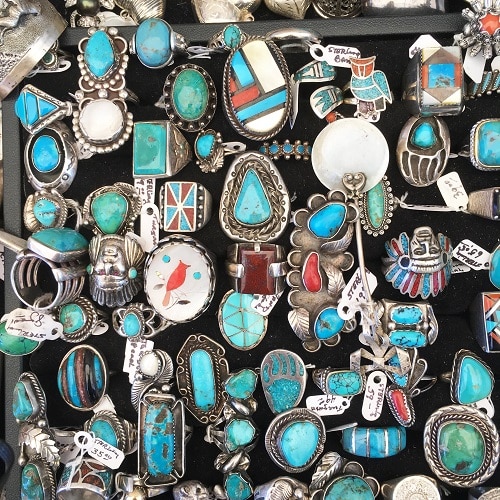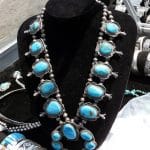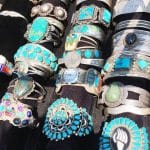By Judy Gonyeau
The very nature and character of turquoise has turned the heads of admirers from Ancient Egypt to China, Tibet to Turkey, and in our glorious Southwest. For over 10,000 years, this stone has captured the attention of the powerful and the artistic, as reflected in carved Chinese relics, Egyptian jewelry and scarabs, and in ritual objects used by Native Americans, Aztecs and Incas, and other indigenous peoples.
Scientifically Speaking
Turquoise is a hydrated copper aluminum phosphate mineral, which will vary in chemical make up, color, density, and more, depending upon the presence of other elements including manganese, calcium, iron, and zinc. While it is not a very hard stone (5-6 on the Mohs scale), it is considered a semi-precious stone.
Because turquoise can change color (ranging anywhere from white to sky blue to navy blue to a yellow-ish green), and it often contains other colors found in nature-including black, blue, green, and occasionally brown, from inclusions of pyrite or dark veins of limonite – Native Americans were drawn to its beauty and what were considered its many mystical properties. Every piece is unique, and appears to tell its own story of origin, formation, and history.
Historically Speaking
“Turquoise” was a word pulled from the French expression “pierre tourques,” or “Turkish stone,” used during the 13th century when it first arrived in Europe.
The oldest jewelry with turquoise, set in gold, was found in Egypt in a set of four bracelets adorning a mummy from around 6000 B.C. The Aztec Indians in Mexico mined turquoise since 900 A.D., using it as a symbol of health, prosperity, and love. Turquoise was used for the decoration of mosques and important buildings in arid countries, and jewelry was found in the Taj Mahal and other palaces.
Early in its history, the finest turquoise was said to be found in Iran and Tibet, but once turquoise from the Southwest United States started to enter the market, it was considered the best – its quality was considered second to none. Today, the U.S. is the largest producer of turquoise in the world.
Beliefs and Myths
In North American Indian myths, turquoise is most commonly mentioned by the Navajo, the Apache, the Hopi, and the Pueblo. This stone is considered by these peoples as one of the most important for body and soul protection, a symbol of heavenly purity, and the most important stone of medicine men, capable of causing rain and protecting them from sickness.
The Zuni carved amulets out of turquoise and decorated limestone-carved figurines of idols with it. Blue turquoise was considered male and symbolized the sky, while green was female and symbolized the earth. The Pima Indians believe that this mineral gives strength and helps to cure diseases. And in the Creation myth of the Acoma Pueblo, the Creator, Iatiku, taught people to use obsidian as a knife and to make holy beads from turquoise and shells.
The Apache believed that if you reach the end of the rainbow after a thunderstorm, you will find turquoise in the wet soil which, if tied to the bow, will make you an invincible hunter who will always hit the target.
The Navajo are known to have the most elaborate development of turquoise. The Navajo female head goddess Estsanatlehi (her other names were Changing Woman or Turquoise Woman) first appeared in the shape of a turquoise female figurine, according to some versions of the tale, and is considered the symbol of creation, protection, and abundance. It is said the beauty and intricate design of American Indian jewelry is due in part to this great goddess.
Silver and Turquoise
While turquoise is set with gold around the world, almost all North American turquoise jewelry is set in silver. Some have thought a Mexican silversmith was the first to start using the combination of turquoise and silver in jewelry, but it was the Navajo, who learned silversmithing from the Spanish and Puebloans in the 1500s, who combined it with turquoise for use during ceremonies and religious rituals. Turquoise was also used in trade with other tribes.
In the early 1900s, a man called Atsidi Chon or “Ugly Smith” started incorporating turquoise into his silver creations. This unique Navajo turquoise jewelry style opened the gates for a whole new world of designs, with the Squash Blossom necklace being one of the most enduring.
The earliest squash blossom necklaces were created in the 1870s and worn by Navajo and Pueblo men and women. The first necklaces were made in plain silver. Scholars believe the “squash blossom” originated from the Spanish-Mexican jacket ornament or buttons that resembled the pomegranate. Navajo silversmiths attached the blossom or trefoil silver beads to the beads on a silver bead necklace. They added the center piece to the bottom which is called the naja or najahe pendant.
The Zuni Indians took up the craft of silver smithing in the 1870s and combined this with their skill in fine stone cutting. The Zuni created jewelry designed around themes in nature, animals, and katsina dancers. Their silver and turquoise necklaces have small hand cut stones and can vary from delicate little necklaces to large turquoise necklaces.
The Santo Domingo artists are best known for their skill grinding, drilling, and stringing heishi beads of shell and turquoise. Their skill in hand rolled beads or rubbed beads in the making of turquoise heishi necklaces is an art for contemporary artists which has carried over to silver in the making of liquid silver necklaces, as well.
Vintage Native American Jewelry
As demand for American Indian turquoise jewelry grew from the advent of tourism and Indian Traders bringing turquoise jewelry to the west coast to market it, Indian jewelry became more refined. Sophisticated tools and gas torches started showing up around 1900-20 and quickly spread throughout the Indian Reservations of the Southwest, and higher production of turquoise jewelry began. The vintage turquoise jewelry from the 1900-40 period is highly collected as it was totally made by hand with natural American turquoise.
Antique Navajo Turquoise Jewelry is considered the most sought-after type of Native American turquoise jewelry, followed by Zuni, Santo Domingo, and Hopi.
Educated vintage turquoise jewelry collectors can pinpoint the date the vintage jewelry was made by the type of turquoise that was used. But all agree it is important to buy from a reputable dealer or auctioneer who consistently presents the best examples of this beautiful collectible jewelry.
According to the Federal Trade Commission, “the Indian Arts and Crafts Act of 1990 helps ensure buyers of Indian arts and crafts products get what they pay for by making it illegal to misrepresent that a product is made by an Indian. Under the Act, any item produced after 1935 that is marketed using terms such as ‘Indian,’ ‘Native American’ or ‘Alaska Native’ must be made by a member of a State or federally-recognized tribe or by a certified Indian artisan. A certified Indian artisan is an individual who is certified by an Indian tribe as a non-member Indian artisan. … Terms such as ‘Indian,’ ‘Native American’ or the name of a particular Indian tribe, accompanied by qualifiers such as ‘ancestry,’ ‘descent’ and ‘heritage’ – for instance, ‘Native American heritage’ or ‘Cherokee descent’ – do not mean that the person is a member of an Indian tribe. These terms do mean that the person is of descent, heritage or ancestry of the tribe, and the terms should be used only if truthful.” Understanding this Act will help ensure you are purchasing a quality piece of Native American craftsmanship.
Caring for Turquoise Jewelry
Do not use ultrasonic cleaners, steamers, chemicals or heat on your turquoise jewelry. Clean your jewelry with warm soapy water and dry with a soft cloth. Then let it air dry. Keeping your turquoise jewelry in an air tight plastic bag will help to avoid tarnish when you are not wearing it.
Sources: durangosilver.com/vintage-turquoise-jewelry; se.edu/procedings-Danchevskaya; gia.edu/turquoise-history-lore; treasuresofthesouthwest.com; garlandsjewelry.com; southwestsilvergallery.com; historyofturquoise.com; consumer.ftc.gov










Related posts: